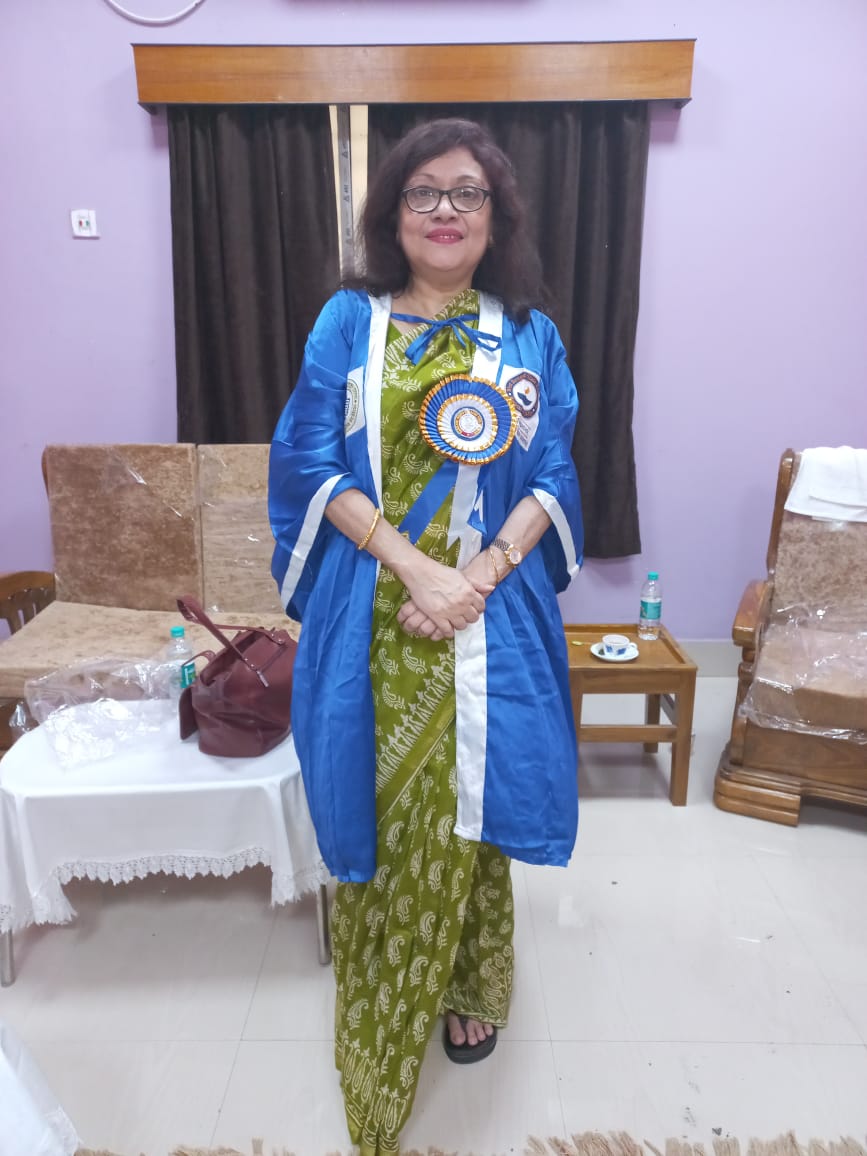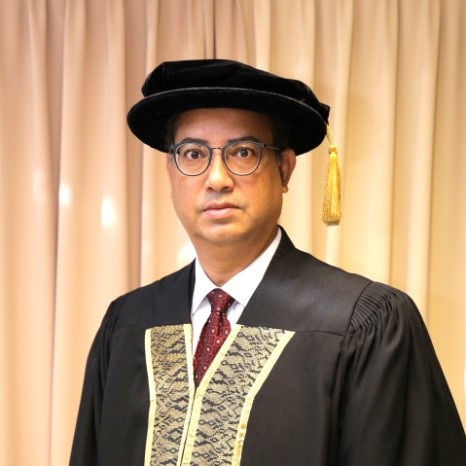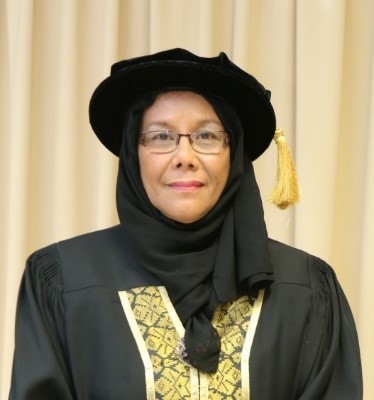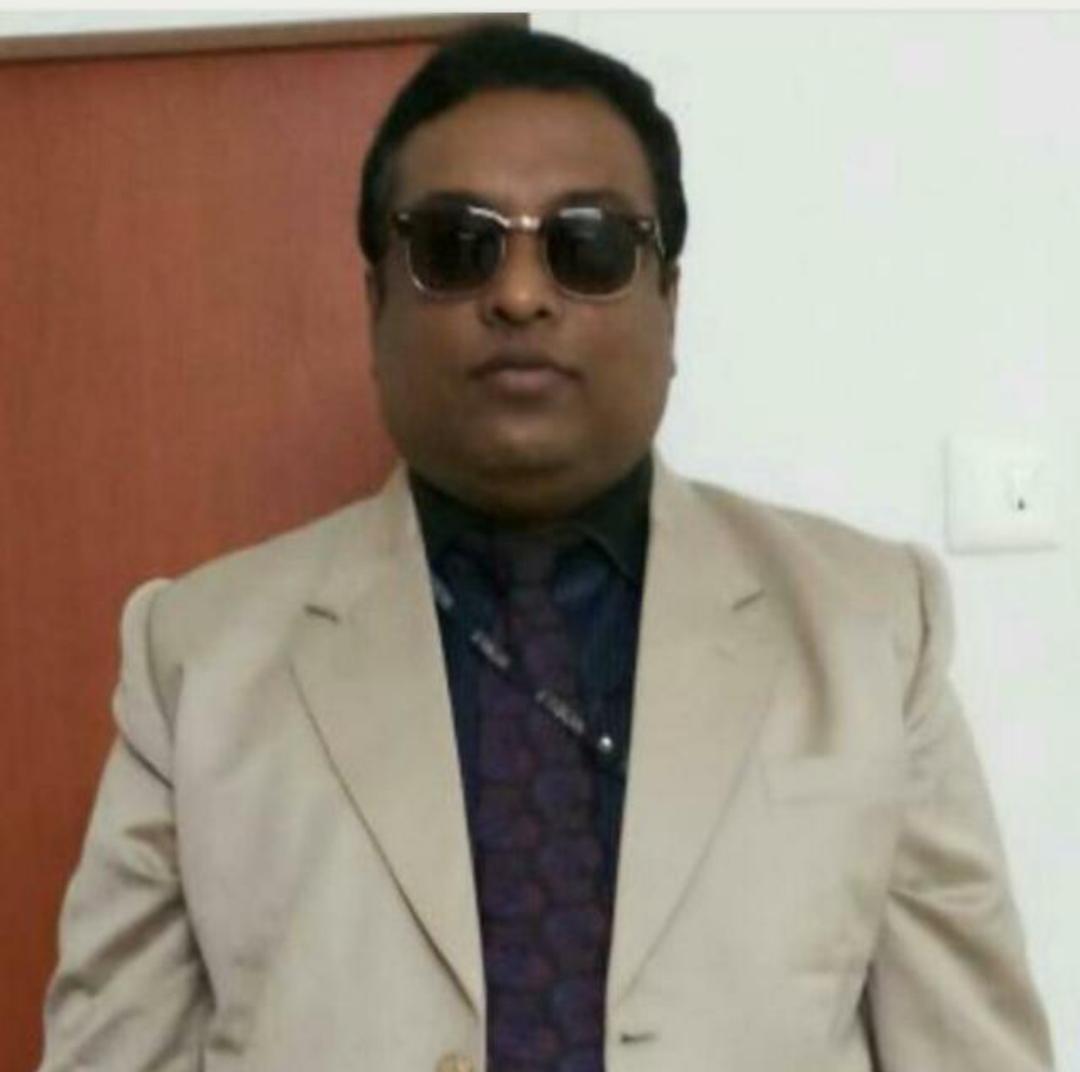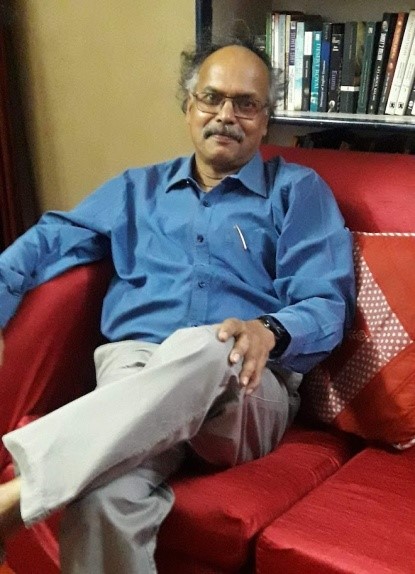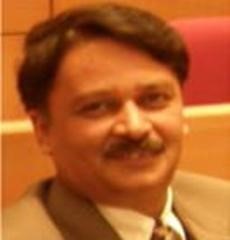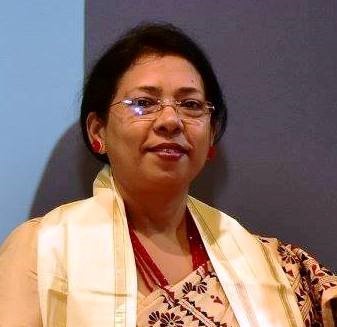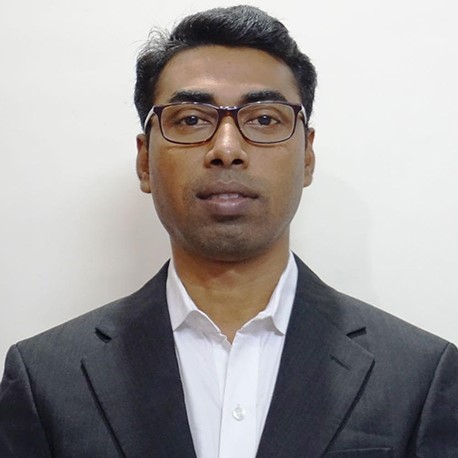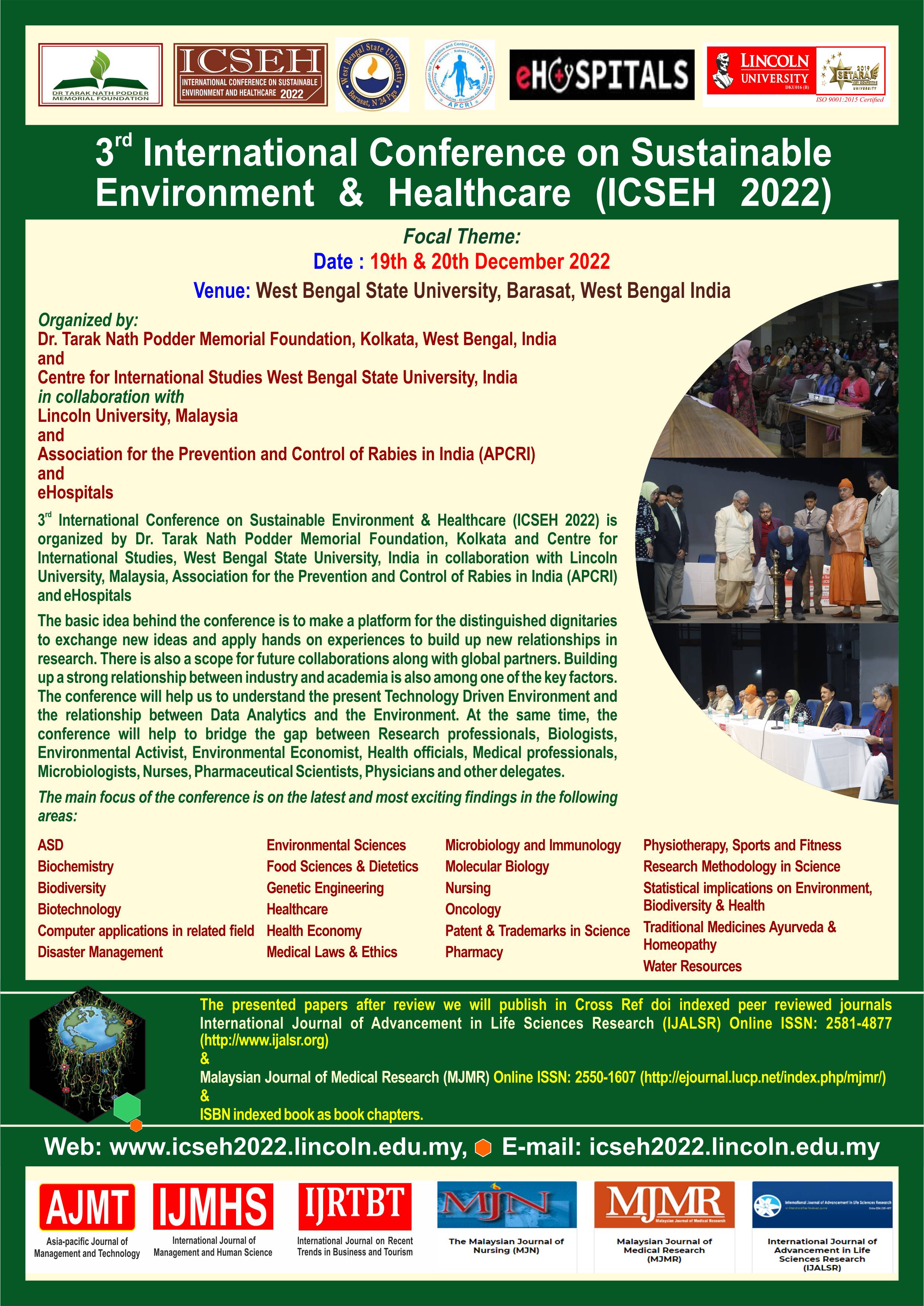About
3rd International Conference on Sustainable Environment & Healthcare (ICSEH 2022) is organized by Dr Tarak Nath Podder Memorial Foundation, Kolkata and Centre for International Studies, West Bengal State University, India in collaboration with Lincoln University, Malaysia, Association for the Prevention and Control of Rabies in India (APCRI) and eHospitals
The basic idea behind the conference is to make a platform for the distinguished dignitaries to exchange new ideas and apply hands on experiences to build up new relationships in research. There is also a scope for future collaborations along with global partners. Building up a strong relationship between industry and academia is also among one of the key factors. The conference will help us to understand the present Technology Driven Environment and the relationship between Data Analytics and the Environment. At the same time, the conference will help to bridge the gap between Research professionals, Biologists, Environmental Activist, Environmental Economist, Health officials, Medical professionals, Microbiologists, Nurses, Pharmaceutical Scientists, Physicians and other delegates.
The main focus of the conference is on the latest and most exciting findings in the following areas:
- ASD
- Biochemistry
- Biodiversity
- Biotechnology
- Computer applications in related field
- Disaster Management
- Environmental Sciences
- Food Sciences & Dietetics
- Genetic Engineering
- Healthcare
- Health Economy
- Medical Laws & Ethics
- Microbiology and Immunology
- Molecular Biology
- Nursing
- Oncology
- Patent & Trademarks in Science
- Pharmacy
- Physiotherapy, Sports and Fitness
- Research Methodology in Science
- Statistical implications on Environment, Biodiversity & Health
- Traditional Medicines Ayurveda & Homeopathy
- Water Resources
Registration Fee
Delegates (Presenters and Participants):
India:2000 INR
International :USD 75*
Research Scholar (Including PhD Scholars):
India: INR 1800
International : USD 50*
Student:
Student : INR 1500
International : USD 30*
Registration Fee include:
Entry to all Sessions
Registration Kit
Lunch
Certificate of Participation.
Payment
Bank Details:
A/c Name : DR TARAK NATH PODDER MEMORIAL FOUNDATION
Account No. : 00330100009546
Bank Name : Bank of Baroda
Branch : Sealdah,Kolkata
IFSC: BARB0SEALDA [Please note the fifth character is ‘Zero’]
Venue
West Bengal State University, Barasat, West Bengal India
Format of Submission
Extended version of selected papers presented in the conference will published after review in the following Journals (with Separate charges as applicable). Please note submission not guarantee publication, all full paper will go through Journal review process.
Scopus, Ministry of Higher Education, Malaysia and Cross Ref. doi indexed Journal:The Malaysian Journal of Nursing (ISSN: 2231-7007; e ISSN: 2462-246X)
http://www.mjn.com.my
Ministry of Higher Education, Malaysia and Cross Ref. doi indexed Journals:
Malaysian Journal of Medical Research (e ISSN : 2550-1607)
http://www.mjmr.com.my
Other Cross Ref. doi indexed International Journal
International Journal of Advancement in Life Sciences Research (e ISSN: 2581-4877)
http://www.ijalsr.org/index.php/journal
International Journal on Recent Trends in Business and Tourism (IJRTBT)
Online ISSN: 2550-1526
http://www.ijrtbt.org/
International Journal of Management and Human Sciences (IJMHS)
Online ISSN : 2590-3748
http://ejournal.lucp.net/index.php/ijmhs
Published By: Lincoln Research and Publishing Limited, Australia (LRPL)
Name:
Asia-Pacific Journal of Management and Technology (AJMT)
Online ISSN : 2652-6840
https://ejournal.lincolnrpl.org/index.php/ajmt
Guidelines for Submission of Full paper :
Articles should contain approximately 1000 to 4000 words. Shorter or longer submissions may be submitted upon approval from the editor.
Articles must be submitted online as an email attachment to: -->
drsandeeppoddar@yahoo.com
Segment the Articles in the following parts:
1. Title Page:
a. Title
b. Running title
c. Author name
d. Corresponding Author Name
e. Affiliation
f. Email
g. Corresponding Author Email
2.Introduction
3. Materials & Method
4. Result
5. Discussion
6. Conclusion
7. Acknowledgement
8. Acknowledgement
9. References
Tables, Illustrations, Figures and Photographs: Graphics such as table, illustrations, figures and photographs must be embedded in the article you are submitting (in MS word).
Structure of Article and Author Guidelines
1. General Information: Please write your article in good English (American or British usage is accepted). Use MS Word format, in one style column with 2 cm margin at each side of A4 paper.
2. Title: The first letter of each word in title, should be typed capital. Please avoid using punctuation marks like (,), (“ “ ), ( ? ), ( ! ), etc. in title and don’t underline words.
*font: Arial, Style: Bold, Size: 14.
3. Authors’ Names: Please write authors’ names after main topic.
*font: Arial, Style: Bold, Size: 11.
Please indicate authors’ postal addresses completely after their names. Country name, telephone number and email addresses of each author are necessary.
*font: Arial, Style: Italic, Size: 11.
4. Abstract:Abstract should be within 250-500 words. Authors need to be careful that the abstract reflects the content of the article accurately.
*font: Arial, Style: Normal, Size: 12.
5. Keywords: Indicate keywords after abstract (3-4words ). Please separate your keywords with ( ,) .
*font: Arial, Style: Normal, Size: 10.
6. Note:
the Articles in the following parts:
i. Title Page :
ii. Title of article.
iii. The full name/s of the authors.
iv. Job title/Occupation, employer, location and affiliation of each author.
v. Name and address of the author responsible for correspondence (Include address, telephone number and email address).
*font: Arial, Style: Italics, Size: 11.
7. Tables: Present tables at the end of the article. Number tables in accordance with their appearance in the text. Place the caption of the table above table. Place explanatory matters below the table. Avoid vertical rules.
*font: Arial, Style: Normal, Size: 10 ( both caption and data in table ).
8. Figures: Present figures, at the end of the article. Number figures in accordance with their appearance in the text. Place the caption of figures and diagrams below them.
*font: Arial, Style: Normal, Size: 10 ( for captions and data in diagram and figures
9. References: Use the Harvard Referencing Guide. Arrange references alphabetically at the end of the article.
*font: Arial, Style: Normal, Size: 12
General Instructions for Author/s:
Types of Articles (Full paper):
Original Articles: Should contain title page, abstract, keywords, introduction, research methods, results and discussion, conclusion, acknowledgement and references. The length of the text should be limited to 12-22 pages including the references.
Review Articles: The review articles are subjected to editorial review such as the original papers.
Case Study: It is included all of the reports about any special issues and new procedure in some limited cases with good results but not confirmed yet internationally as a global choice. It should be not exceed more than 2000 words.
Structure of Articles: Title Page: Should contain title which should include the study design, author(s) information such as the first name, last name, highest academic degree and affiliation. Abstract: Should contain background, research methods, results and conclusion sections separately. The objective of study, findings (including its statistical significance) and the conclusion made on the basis of the findings should be clearly presented. Abstract is not necessary for case reports, while review articles should have an abstract. Nevertheless, the length of an abstract should be less than 250 words. Authors need to be careful that the abstract reflects the content of the article accurately.
Keywords: Each submitted article should contain 3-4 keywords.
Keywords will assist indexers in cross indexing the article as they are published with abstract.
Introduction: This should summarize the purpose and the rationale for the study. It should neither review the subject extensively nor should it have data or conclusions of the study.
Research Method: This should include exact method or observation or experiment. Mathematical and Statistical methods must be mentioned and specify any general computer package used.
Results and Discussion: must be presented in the form of text, tables and illustrations. The contents of the tables should not be all repeated in the text. Instead, a reference to the table number may be given. Long articles may need sub-headings (mentioned on page1 as Subdivisions) within some sections to clarify their contents.
Discussion should emphasize the present findings and the variations or similarities with other work done in the field by other researchers. The detailed data should not be repeated discussion again. Emphasize the new and important aspects of the study. It must be mentioned whether the hypothesis mentioned in the article is true, false or no conclusions can be derived.
Conclusion: The conclusion allows you to have the final say on the issues authors have raised in the paper, to summarize the thoughts, to demonstrate the importance of the ideas, and to propel reader to a new view of the subject. It is also the opportunity to make a good final impression and to end on a positive note. The conclusion should represent something important to the readers, and can be used for some, or all of the following tasks:
• Emphasizing the purpose and importance of the article
• Explaining the significance or consequences of the findings
• Indicating the wider applications of the method developed in the article
• Establishing the article as the basis for further investigation
Acknowledgement: All contributors who do not meet the criteria for authorship should be covered in the acknowledgement section. It should include persons who provided technical help, writing assistance and departmental head that only provided general support. Financial and material support should also be acknowledged. Author(s) must acknowledge and declare any sources of funding and potential conflicting interest, such as receiving funds or fees by, holding stocks and shares in and organizations that may profit or lose through publication of your paper. Declaring a competing interest will not lead to automatic rejection of the paper, but we would like to be made aware of it.
Submission: Manuscripts must have been written in English. Also the manuscript must have confirm letter that is assumed manuscripts are exclusively submitted to the conference journals (MJMR / MJN) and have not been previously published elsewhere (except in the form of an abstract or as part of a published lecture, review or thesis) and are not under consideration by any other journal. In the covering letter one author should be specified as the "corresponding author" and all other authors should personally sign the covering letter. Authors are responsible for all statements made in their work. The editorial board has the right to insert any necessary changes so that the manuscript is harmonized with the editorial framework of the journal. All submissions to the (MJMR / MJN) should contain a completed copy of signed covered letter containing the copyright agreement.
Final Checklist: The authors must ensure that before submitting the manuscript for publication, they have taken care of the following:
1. Title page should contain title, name of the author(s), their qualifications, mailing address for future correspondence, email address, phone and fax number.
2. Abstract in structured format up to 250 words.
3. Keywords contain 3-4 words.
4. References should be typed as instruction that mentioned above.
5. Tables and figures should be typed at the end of the article.
6. Copyright (covering) Letter.
Call For Papers
The researchers are invited to submit their abstracts mentioning the mode of presentation (Oral)
Abstract must be submitted within 5th December, 2022
Full article must be submitted within 7th December, 2022 for the Journal publication.
Scopus, Ministry of Higher Education, Malaysia and Cross Ref. doi indexed Journal:
The Malaysian Journal of Nursing (ISSN: 2231-7007; e ISSN: 2462-246X)
http://www.mjn.com.my
Malaysian Journal of Medical Research (e ISSN : 2550-1607)
http://www.mjmr.com.my
Other Cross Ref doi & Index Copernicus indexed Journal
International Journal of Advancement in Life Sciences Research (eISSN: 2581-4877)
Proceedings book with CrossRef doi and ISBN will be released later
The editor reserves the right to choose the journal as per relevance and subject of the paper.
Accommodation
A limited number of accommodation can be arranged at Guest houses
Kindly mail request to:
icseh@lincoln.edu.my
Contact
Dr. Sandeep Poddar
Deputy Vice Chancellor (Research & Innovation)
Lincoln University, Malaysia
Prof. Dr. Pranam Dhar
Professor & Head, Department of Commerce & Management,
Programme Coordinator - NSS,
&
Director - Centre for International Studies
West Bengal State University, West Bengal, India
Lincoln University,
Wisma Lincoln, No. 2, SS 6/12,
Off Jalan Perbandaran, 47301 Petaling Jaya,
Selangor D. E., Malaysia
Phone : 1300 880 111 (Malaysia)
Phone : +603-7806 3478 (International)
FAX : +603-7806 3479
H/p : +60127071827
Email : icseh@lincoln.edu.my
Collaboration

International Journal on Recent Trends in Business and Tourism (IJRTBT)

International Journal of Management and Human Sciences (IJMHS)
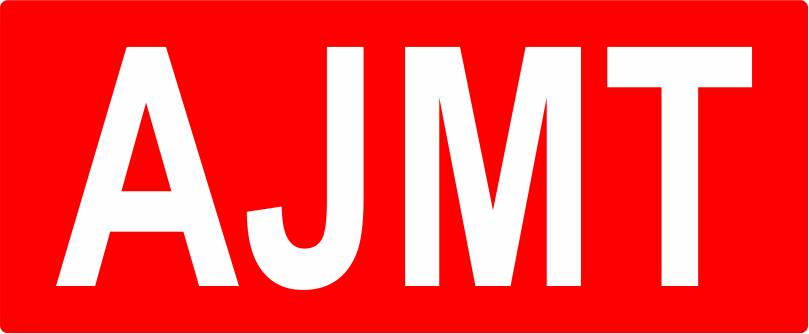
Asia-Pacific Journal of Management and Technology (AJMT)
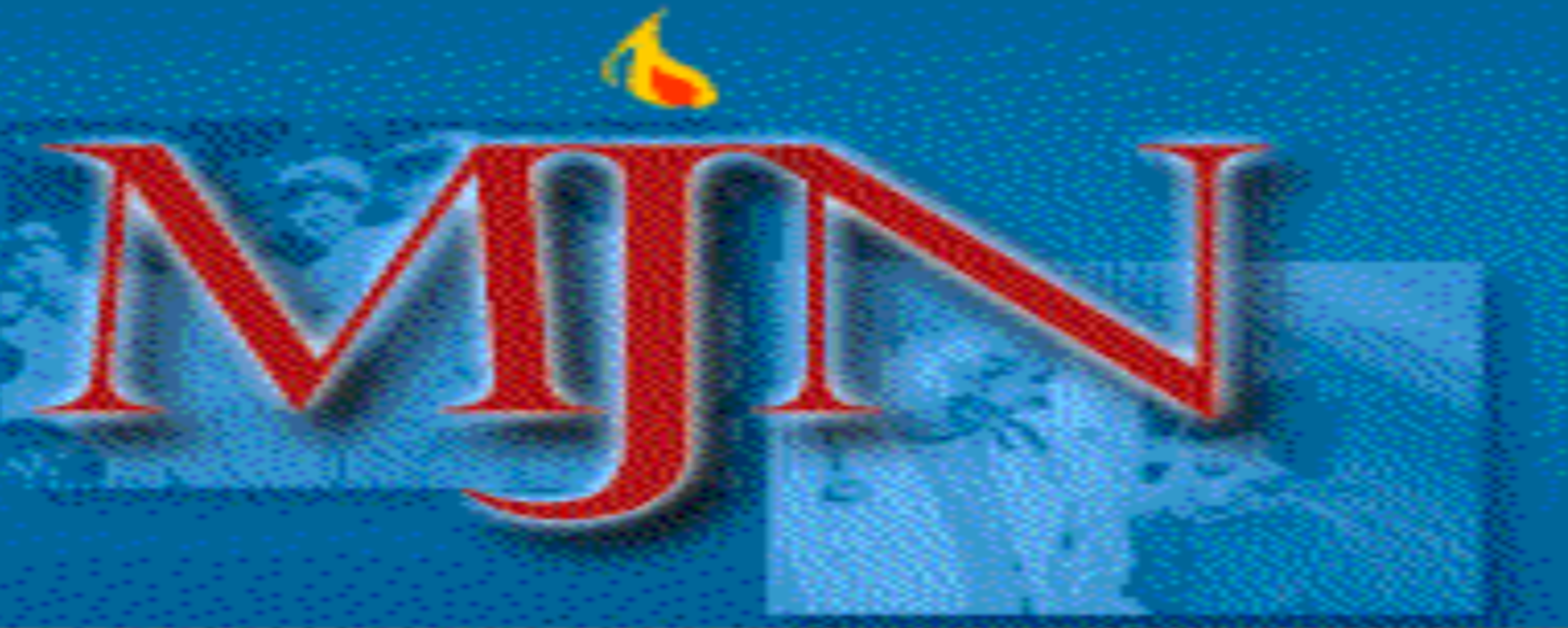
The Malaysian Journal of Nursing (MJN)
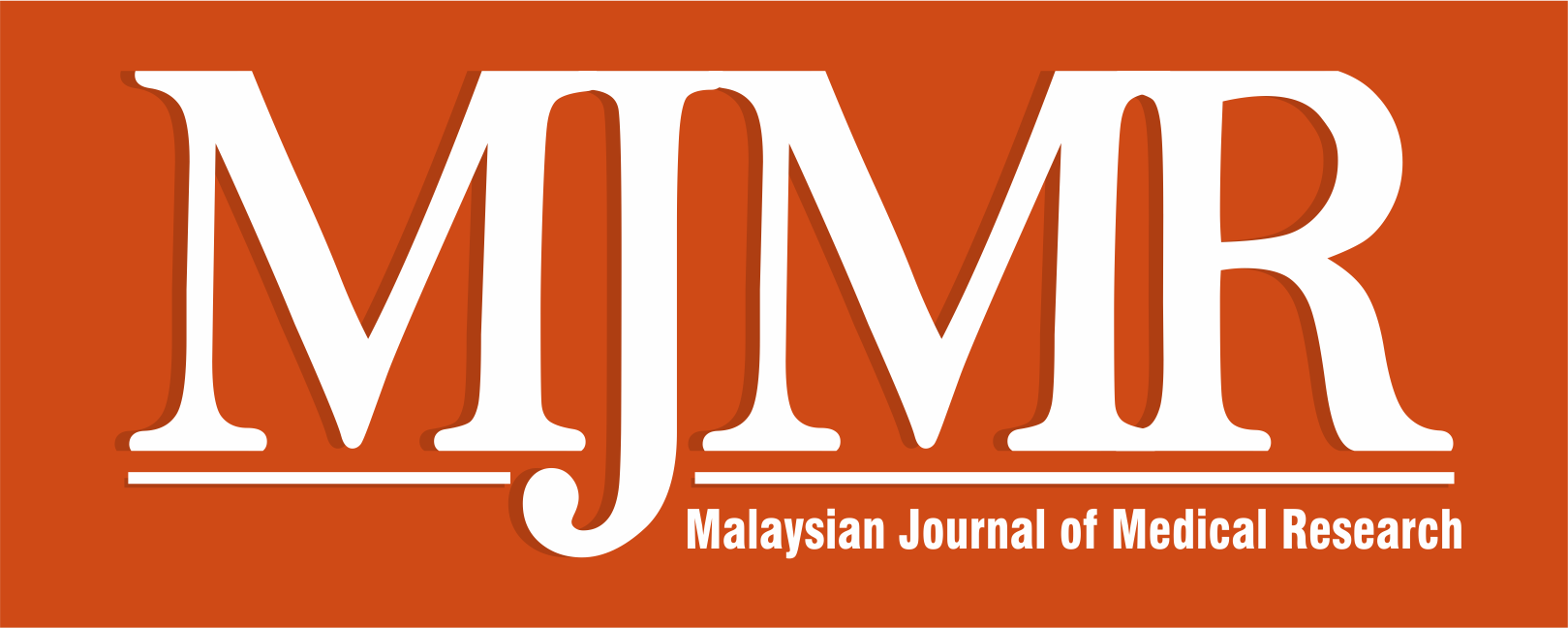
Malaysian Journal of Medical Research (MJMR)
International Journal of Advancement in Life Sciences Research (IJALSR)
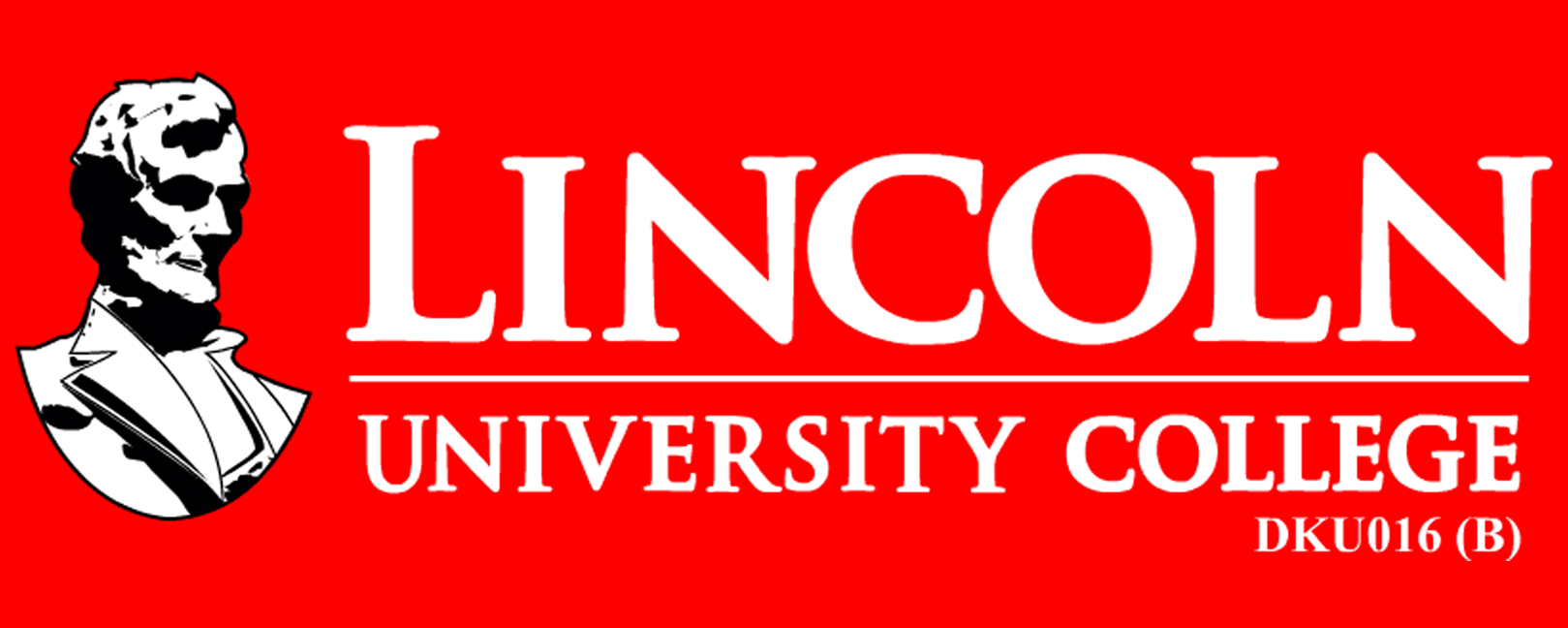
Lincoln University (LU)
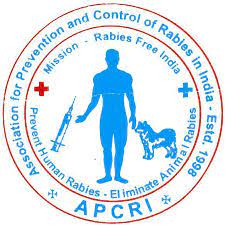
Association for the Prevention and Control of Rabies in India (APCRI)


